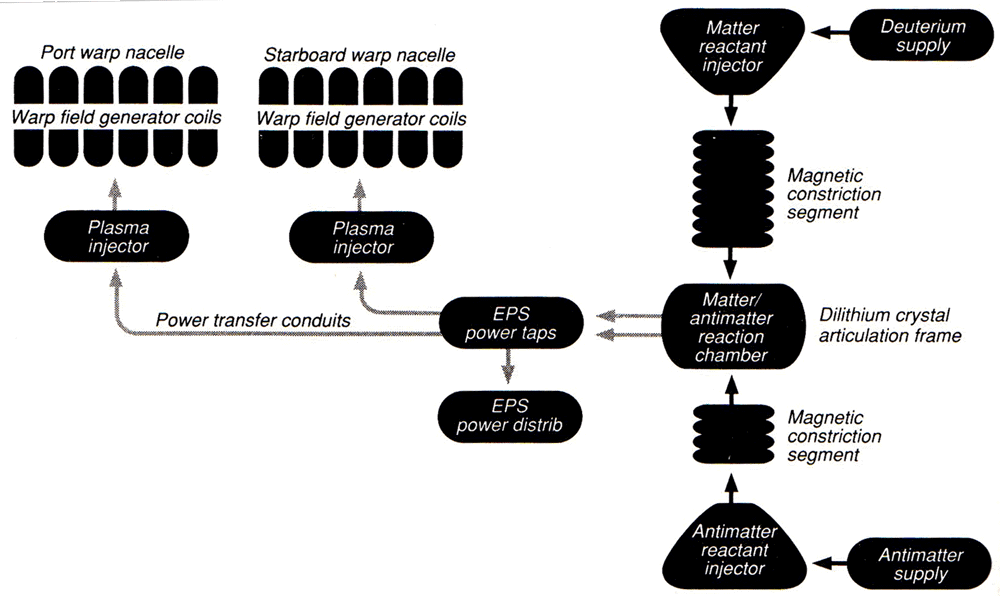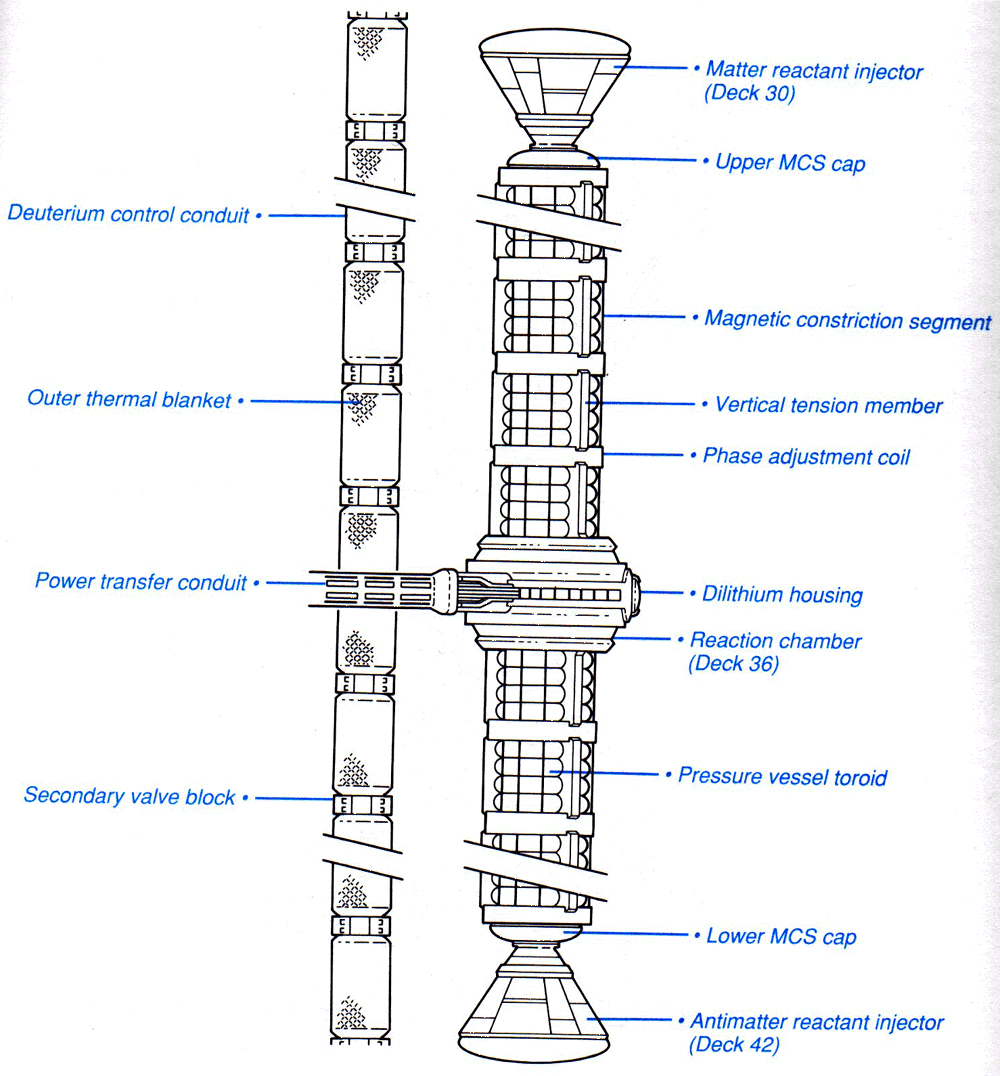
Warp Propulsion in Kelly Class Starships
By Lt. George Bogler
Chief Engineer U.S.S. Kelly NCC-73400
Seventh Fleet
The most noticeable difference between a Kelly Class Starship and a Galaxy Class Starship is that the former has four warp nacelles-2 in the same position on the "stardrive" section as the Galaxy Class and two more mounted on the saucer section (inboard of the lower pair). Since becoming Chief Engineer of the U.S.S. Kelly I have found that many do not understand the basics of the dual warp core and propulsion systems used in the Kelly class. This paper shall explain in layman's terms the distinct advantages of these vessels. The diagrams in the appendix should help too.
Before proceeding, it is necessary to understand the basics of warp propulsion theory. Warp, as we all should know, is a measurement of faster-than-light (ftl) speed. The power for warp speed comes from the controlled annihilation of matter and anti-matter-specifically deuterium (hydrogen-2) and anti-deuterium. In addition to providing ftl propulsion, there is sufficient excess energy to provide primary power to all ship's systems. As a backup, and when travelling at high warp speeds, secondary power can be drawn from conventional fusion reactors or batteries. Thus, with two warp cores, Kelly Class Starships have more power available than ships with only a single core.
Warp speed is achieved when sufficient power is sent from the core to the warp coils (located in the nacelles) to energize them. Feeding the coils this energy causes them to produce a sub-space field (sometimes referred to as a warp field) much like powering an electromagnet produces a magnetic field. The power and shape of the sub-space field determines a ship's direction and speed. Warp coils are always energized in pairs (one in each nacelle, left & right). If mis-aligned the coils produce warp fields with different properties and this can result in the ship literally tearing itself apart. Warp fields are measured in terms known as "Cochranes", and to be even more accurate, "Milicochranes" (1/1000 of a cochrane). The term derives it's name from Zephram Cochrane, the inventor of the warp drive (for the human species)*. To cross the "warp threshold", or in other words-break the light-speed barrier, requires one cochrane (1000 milicochranes) of energy from the warp core fed into the warp coils.
Some of you will now be asking, well, what about ships we have seen with three nacelles ("future Enterprise") or even four (U.S.S. Stargazer, U.S.S. Prometheus)? The Star Trek: The Next Generation Technical Manual* (section 5.3) states only that,
"...in 2269 it experiments...concluded that two nacelles was the optimum for power generation and vehicle control." This leaves us to assume that these other ship configurations are the result of outdated, experimental, or future technology. It is also obvious that the simultaneous use of more than two nacelles greatly increases the complexity of the intermix equations-the precise calculations of matter/anti-matter ratios. Furthermore, except for the Prometheus, those ships contained only a single warp core. In the case of the Prometheus, it is a revival of the technology designed for the Kelly class and which has been in use in that class for 12 years.During normal operations, the U.S.S. Kelly utilizes the "primary" warp core located in the lower half of the ship (stardrive or battle section, in Galaxy Class terminology) for propulsion while keeping the secondary core in the saucer section "ticking over" at anywhere from 200-800 milicochranes. This prevents the necessity of a cold start in an emergency. Power from the secondary core is shunted into the eps system for ship operations, as is excess power from the primary. This results in a power surplus most of the time, and the surplus must simply be bled off (usually as waste heat). Although theoretically possible to operate with two independently generated warp fields, it is extrememely dangerous, and has never been attempted outside of computer models.
However, it is during combat conditions that the existence of the secondary core proves an overwhelming tactical advantage. First, running both cores allows the shields to absorb greater punishment and to stay on-line longer, as well as allocating power to the weapons systems (including a phaser cannon). Also while running both cores, the Kelly can not only cloak, but also fire her weapons while cloaked. Second, like a Galaxy Class vessel, the Kelly can separate into two sections. However, the Kelly class has the advantage of a warp-capable saucer section-its independent core providing equal power, but with lesser mass and fewer systems to run as compared to joined mode. In fact while operating in separated mode, the Kelly can cloak both sections, although they cannot fire weapons while cloaked as when joined. Third, although heavier by four decks, and more gravid-looking (i.e. pregnant) in the lower section than the Galaxy Class, the secondary core allows the Kelly class to be more maneuverable and accelerate faster. Of course this advantage is lost on the lower section during separated mode, and in the saucer section at impulse speeds.

A WARP ENERGY FLOW CHART
 Diagram of a typical warp core
Diagram of a typical warp core

The matter & anti-matter injection assemblies and the reaction chamber

Ejecting the (primary) warp core
(The secondary core on the U.S.S. Kelly ejects upwards from just aft of the bridge module)
*Information and graphics for this article were taken from Startrek: The Next Generation Technical Manual,by Rick Sternbach & Michael Okuda (copyright 1990 Pocket Books & Paramount Pictures). Please do not directly link to or download these graphics. Feel free to link to the article however.